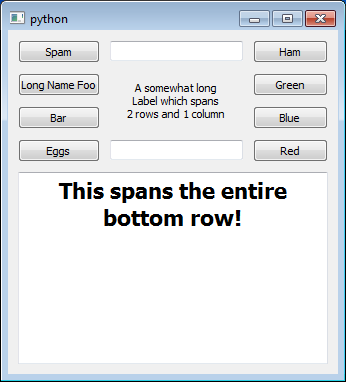#------------------------------------------------------------------------------
# Copyright (c) 2013, Nucleic Development Team.
#
# Distributed under the terms of the Modified BSD License.
#
# The full license is in the file COPYING.txt, distributed with this software.
#------------------------------------------------------------------------------
""" An example which demonstrates the use of the `grid` layout helper.
In this example, we use the `grid` layout helper to layout the children
of the Container in a grid arrangment. Similar to the `vbox` and `hbox`
functions, the `grid` function will automatically take into account the
the content boundaries of its parent and provides the necessary layout
spacers to arrange things nicely.
The `grid` function allows items to span multiple cells by assigning the
same item to multiple cells. No checks are performed to ensure an item
spans a continugous cell block. Instead, items will span the smallest
rectangular cell block which encloses all of its locations. Empty cells
are defined by using `None` as the cell item.
Inter-row and inter-column spacing of the grid is controlled with the
`row_spacing` and `column_spacing` keyword arguments both of which
default to 10.
Addition row and and column alignment constraints can be supplied with
the `row_align` and `column_align` keyword arguments. These are strings
which are supplied to the `align` layout helper for the items in a given
row or column. However, these constraints are only applied to items which
span a single row or column, respectively.
<< autodoc-me >>
"""
from enaml.layout.api import grid
from enaml.widgets.api import Window, Container, PushButton, Label, Field, Html
enamldef Main(Window):
Container:
constraints = [
grid(
[pb1, fld1, pb5],
[pb2, lbl, pb6],
[pb3, lbl, pb7],
[pb4, fld2, pb8],
[html, html, html],
column_align='width',
row_align='v_center',
),
]
PushButton: pb1:
text = 'Spam'
PushButton: pb2:
text = 'Long Name Foo'
PushButton: pb3:
text = 'Bar'
PushButton: pb4:
text = 'Eggs'
PushButton: pb5:
text = 'Ham'
PushButton: pb6:
text = 'Green'
PushButton: pb7:
text = 'Blue'
PushButton: pb8:
text = 'Red'
Field: fld1:
pass
Field: fld2:
pass
Label: lbl:
text = 'A somewhat long\nLabel which spans\n2 rows and 1 column'
align = 'center'
hug_height = 'weak'
Html: html:
source = '<h1><center>This spans the entire bottom row!</center></h1>'
